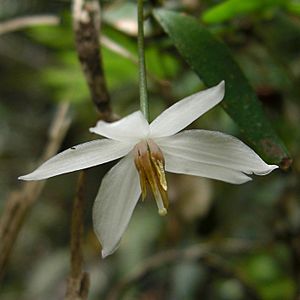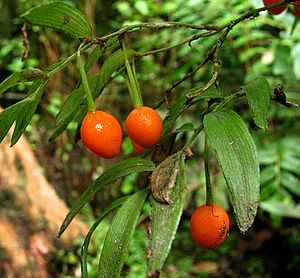Luzuriaga radicans facts for kids
Quick facts for kids Luzuriaga radicans |
|
|---|---|
 |
|
| Luzuriaga radicans | |
| Scientific classification | |
| Genus: |
Luzuriaga
|
| Species: |
radicans
|
| Synonyms | |
|
|
Luzuriaga radicans is a special kind of flowering plant. People also call it quilineja. It belongs to a group of plants called Luzuriaga. This plant family is known as Alstroemeriaceae, which includes Inca-lilies. It's part of a larger group of plants called monocots.
Contents
About the Quilineja Plant
The quilineja plant is an evergreen climber. This means it stays green all year round. It uses its thin roots to stick to tree trunks and climb up them.
Leaves and Flowers
The leaves of the quilineja plant grow in a special way. They are light green and shaped like a long oval, with a pointed tip. Each leaf is about 1 to 4 centimeters long. On the underside of the leaves, you can see 9 to 13 thin white lines.
The flowers are white and about 1 centimeter long. They can grow alone or in small groups of 2 to 4 flowers. Each flower has six white parts called tepals, which are like petals. The flowers also have six stamens, which produce pollen. A part called the style is longer than the stamens and has a three-part tip called a stigma.
Fruit and Seeds
After the flowers, the plant grows a smooth, round fruit. This fruit is red-orange and about 0.8 to 1 centimeter wide. Inside the fruit, there can be up to twelve flat seeds. Each seed is about 4 millimeters long.
How Quilineja Got Its Name
The plant Luzuriaga radicans was first described in 1802. Two Spanish botanists, Hipólito Ruiz López and José Antonio Pavón Jiménez, gave it its scientific name. They are known as Ruiz et Pavón.
What "Radicans" Means
The second part of the name, radicans, comes from a Latin word. It means "with rooting stems." This name fits the plant well because it climbs by using its roots to stick to trees.
Where Quilineja Grows
Luzuriaga radicans is found in South Central and South Chile, and also in South Argentina. In Chile, it grows from the Colchagua area down to Aisén.
Preferred Environment
This plant likes places that are shady and humid. It needs constant rainfall and grows well under thick plant cover. Near the coast, it can be found up to 500 meters high. In coastal mountain areas, it grows between 500 and 2,000 meters high. You can also find it in low-lying valleys further inland.
Quilineja's Habitat
The quilineja plant often grows in wet places. Its roots can be in water, like in marshes, bogs, or along the shores of lakes and rivers.
Protecting Quilineja
Sadly, the quilineja plant is becoming harder to find. This is because too much of it has been used, and many forests where it grows have been destroyed. However, you can still find it in protected areas. One such place is the Llancahue reserve, which is near the city of Valdivia.
Growing Quilineja
It is quite hard to grow quilineja plants. If a vine is taken from a tree, it can take about five years for it to grow back.
How People Use Quilineja
People value Luzuriaga radicans for several reasons.
Crafts and Tools
The stems of the plant are used to make many things. They are used for household items and beautiful handicrafts. For example, people use them to make basketry and brooms. In the past, it was also used for fences and ropes. Today, it is mostly used for special artisanal crafts.
Edible Fruit
The fruit of the quilineja plant can be eaten raw. It used to be a traditional food for people in the area. However, it is not as commonly eaten today.
See also
 In Spanish: Luzuriaga radicans para niños
In Spanish: Luzuriaga radicans para niños


